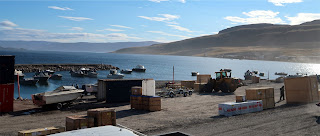The Taiga Desgagnes arrived in Arctic Bay on August 26, the same day Inuujaq School held its community picnic. The large ship arrived to deliver a variety of supplies to the community. My sealift order, as well as the school’s, was on that ship.
The bay is deep enough for large ships to anchor close to shore, cutting down the time needed to move supplies. However, the captains frequently choose to anchor the ships in the middle of the bay. I guess if they anchored too close to the shoreline, they would need a lot of time to move back and/or turn the ship around to leave. I’ve said this many times before: a deep-sea port would make the delivery process so much easier and safer. Unfortunately, the powers that be are too slow to react. I think they’re waiting to see how the new deep-sea port in Iqaluit will work when it becomes operational next year.
The Desgagnes crew operated two tugboats and barges to ferry supplies. Many were packaged in large sea containers and wooden crates. Vehicles, on the other hand, were shipped as they were so that they could be driven off the barges. The unloading area was in front of the Northern Store. Everyone had to avoid this area or be careful when passing through. Large loader machines were in operation and their drivers couldn’t see everywhere.
I took a few photographs on the day of the picnic. The Hamlet Office bought a new sewage truck. I found my wooden crate as well as three large crates addressed to the school. An assortment of Co-op sea containers were assembled in a large pile. Some of the containers had pieces cut out. I wondered if they would be used to assemble a building somewhere.
The ship left before I could sign the paper to claim my wooden crate. Thankfully, the crate wasn’t returned to the ship. Unfortunately, I couldn’t find someone to move it to my residence, so I borrowed a truck from Frank and enlisted the help of a co-worker. We would open the crate, load everything onto the truck, and divide my order into two groups. My personal items would be moved to my residence and the school supplies would be moved to the school.
The
co-worker and I stepped up to my crate, armed with crowbars, axes, and screw
drivers. We attacked the crate at the corners,
trying to tear off nails and pieces of wood.
The loud banging sounds attracted the attention of kids wanting to help. For them, sealift is like an early
Christmas. We managed to get one side of
the crate open. The kids loaded
everything onto the truck in a few minutes.
I thanked them by giving them cans of Coke Zero. I told them it was either that or nothing. I don’t drink sugary pop anymore. The kids dispersed after receiving their “payment”.
The co-worker & I unloaded the school supplies first and then drove to my place to move my personal items inside. I dropped him off at his place and then returned to school. I used a cart to move all my supplies to my classroom. I spent a good hour unpacking and placing everything where it needed to be. When I was done, I photographed the school supplies lining the main hallway.
School Administration hired a local mover to move the large wooden crates to the front of the school, and several people to move all the items inside the building. The main hallway looked like a warehouse stocked with cardboard boxes. I assumed the supplies would be sorted and distributed during the upcoming week.
I
returned home and spent the remainder of the day unpacking my personal items
and rearranging my residence. My place also
looked a fully stocked warehouse. This would
gradually change throughout the year and come next spring, my sealift supplies
would be gone.





.JPG)
.JPG)

.JPG)
.JPG)
.JPG)

No comments:
Post a Comment